Blockchain + Medical Research Report: The biggest pain point of data and traceability, blockchain technology may save more than 100 billion US dollars in costs each year
Written by: OKEx Analyst Xiu Xiu
Editor's Note: The original title was "OKEx Investment Research | Blockchain Empowering Medical Industry Report"
Foreword
On the whole, the medical industry can be divided into two categories: medical services and pharmaceutical commerce. The main pain points of the industry are the failure to make full use of data in medical services and the traceability of anti-counterfeiting sources of traditional Chinese medicine products in pharmaceutical commerce.
Traditional medical data has encountered many difficulties in the development of informatization. Compared with other traditional industries, the development progress is extremely slow. The fundamental reason is that the traditional participants are less willing to informatize due to the current siloed medical data and the lack of a standard system, data security is difficult to guarantee, and the data right is not clear. The medical data in medical services has not been fully utilized.
- Blockchain 2B company is hot: the company takes orders madly, employees 996, year-end awards have increased significantly
- BTC block reward is about to be halved, will its security rate be halved?
- Industry Blockchain Weekly 丨 Blockchain writes 7 provincial government work reports, Baidu and Tencent enter A shares
However, due to the large number of participants in the supply chain of the pharmaceutical industry, there is a large number of interactions and collaborations. Information is discretely stored in their own systems and lacks transparency. The fluency of information makes it difficult for participants to accurately understand the real-time status of related issues and existing problems, which affects the efficiency of supply chain collaboration. When disputes arise between the subjects, proof and accountability are time-consuming and laborious.
The blockchain has natural advantages in data confidentiality, smart contracts, ecological incentives, etc., and has a high degree of agreement with the medical industry. It can provide multi-link security solutions for the medical industry, and it can also promote the intelligentization of the medical industry. development of.
I. Introduction to the medical industry
1.1 Medical Industry Structure
Medical security is not only related to the vital interests of each member of society, but also directly related to the sustainable development and comprehensive competitiveness of a country. The medical service system is a service chain that includes primary prevention, outpatient medical treatment, inpatient medical treatment, and rehabilitation medical care. The medical service research and development, production and sales system, and medical insurance expense collection and payment system support the medical service chain. Only these three systems The healthy and coordinated operation of the system can achieve the maximum medical security and the maximum utility of medical resources in the whole society.
The upstream of the medical industry chain mainly includes medical drug production R & D and medical device production R & D; midstream includes large medical institutions and small institutions that provide medical services. Large institutions mainly refer to public hospitals and large private hospitals, drug store chain institutions, and small institutions refer to communities. Hospitals and private clinics; patients downstream in the medical industry chain.
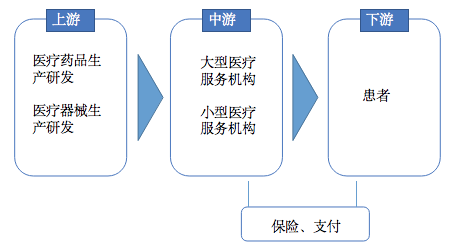
Pictures from OKEx Investment Research
1.2 Market Size of Medical Industry
According to wind data, in 2015, the global medical industry scale was approximately $ 1 trillion, and the value of the global digital medical market was $ 80 billion (8%), and it is expected to increase to more than $ 200 billion (15%) by 2020 "* 20%), a compound annual growth rate of 21%. The global digital medical market is developing rapidly.
Relevant data show that the scale of China's large health industry market will reach 10 trillion yuan in 2020, which has become a new outlet. In the next ten years, the medical and health market will maintain a steady growth trend. From the perspective of supply and demand, on the one hand, with the further aging of society, the per capita disposable income has been steadily increased, and the demand for health has been fully released; on the other hand, medical technology, biotechnology, intelligent technology and other technologies The development promotes the substantial improvement of the supply-side products and services of the health industry, so that more health needs can be met.
Feasibility analysis of blockchain-enabled medical
2.1 Pain points in the medical industry:
On the whole, the medical industry can be divided into two categories: medical services and pharmaceutical commerce. The main pain points of the industry are the failure to make full use of data in medical services and the traceability of anti-counterfeiting sources of traditional Chinese medicine products in pharmaceutical commerce.
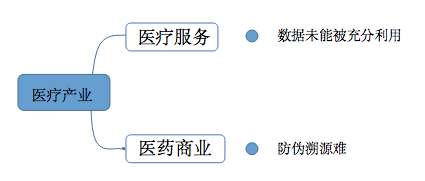
Pictures from OKEx Investment Research
2.1.1 Underutilization of medical data
With the popularization of medical informatization and the promotion of electronic medical records, medical institutions generate, store, and flow a large amount of data about diseases, medical treatment, and clinical trials of drugs every day. At the same time, with the advent of more medical-grade wearable smart devices, this field is annually The amount of data is growing rapidly. The field of medical and health is entering the era of big data of medical and health. Data is the most important means of production. The information obtained through data analysis and mining will have impossibility in business, scientific and technological decisions, optimization of resource allocation, and saving of capital. Comparable value and potential.
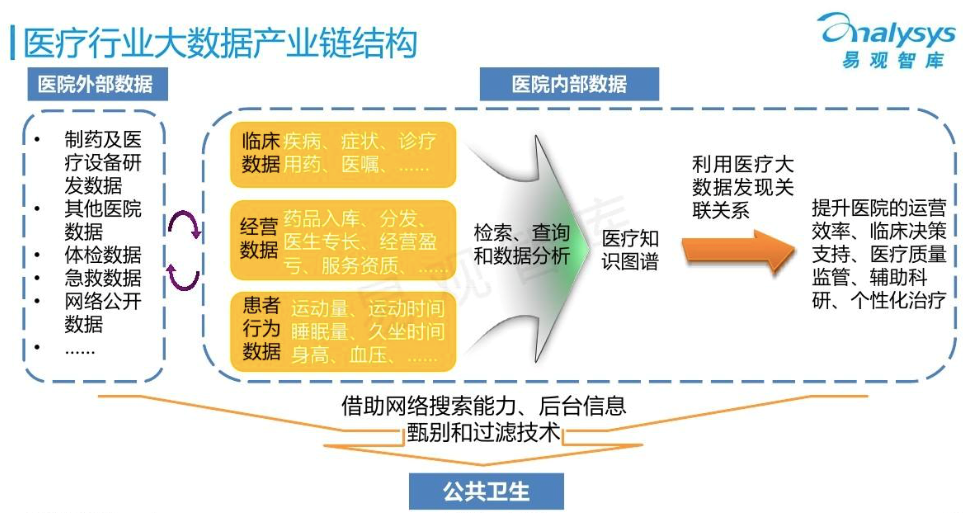
Pictures from Analysys Think Tank
Traditional medical data has encountered many difficulties in the development of informatization. Compared with other traditional industries, the development progress is extremely slow. The fundamental reason is that the traditional participants are less willing to informatize due to the current siloed medical data and the lack of a standard system, difficult data security, and unclear data rights, and medical data in medical services has not been fully utilized.
(1) Medical data is siloed and lacks a standard system
As far as the current medical system is concerned, different medical institutions have their own policies and have mastered the medical data of different stages and patients. With the end of each medical service, these medical data are scattered everywhere, and a complete and coherent chain system cannot be formed. Therefore, at the next consultation, in order to ensure the understanding of the patient's medical history, the doctor needs to ask the patient again and the second test, which brings a huge waste of manpower and material resources.
If a person's medical health history can be fully recorded, it will greatly simplify the diagnosis and treatment process. Doctors can intuitively understand the drugs the patient has taken, the previous doctor's order, the previous illness and the method of diagnosis and treatment when they are consulting the patient. When they make this diagnosis, they can be more accurate and efficient. The level of medical treatment and coordination Sexuality is further improved, and the risk of misdiagnosis is reduced.
In addition, the distribution of key patient data and information in different departments and systems has also led to the lack of an entire industry standard system. There is no standardized medical data recording system among medical institutions. Even if medical data is shared with each other, it cannot be integrated and effectively used. At the same time, the large health data collected by various intelligent devices are also mostly disorganized and unable to form effective data.
(2) Medical data security is difficult to guarantee
Take a complete diagnosis and treatment file as an example, which contains various information, such as basic patient information, diagnostic information, doctor's order information, inspection information, medicine information, charge information, doctor information, etc. Great harm to personal privacy. In particular, important health data such as fingerprint data (most payment methods involve fingerprint payment), genetic data, and iris data are stored in a centralized manner. Once a large-scale leak occurs, it will have catastrophic consequences.
Traditional medical data may be leaked due to internal errors or external attacks. The difficulty of privacy protection in the medical system is that there are many potential leaks caused by many participants. There is a single point of failure problem in the centralized database and a single private key leak causes the database security defense line to completely collapse. External attacks cannot be prevented. The existing Storage mode does not achieve its security.
In the 2016 Mid-2016 Review: 2016 Cyber Security Threat Analysis Report released by HEIMDAL, the global medical industry was the industry most attacked by ransomware in the year, of which the second quarter accounted for 88 %. The British "Guardian" investigation on February 27, 2017 also revealed that the National Health Service (NHS) in the UK lost up to 500,000 pieces of medical information. The emergence of large-scale medical data leaks is endless, reflecting the current state of urgent need for technological innovation in the entire industry.
(3) Unclear ownership of medical data:
The advancement of medical level is closely related to human health. The work of clinical medicine and medical research depends on the collection, analysis and use of medical information by medical workers. For example, clinical medical assessments and reviews often involve multiple drug use and various clinical medical diagnostic results, and therefore need to integrate medical data from multiple sources for longitudinal cross-over studies and comprehensive comparisons. The rising Internet data mining and analysis industry has become the main force to promote the development of commercial medical informatization. Take IMS Health, a leader in the global data mining industry, as an example. In order to obtain vertical or life-long communication with patients or the medical system, in addition to purchasing medical data from the medical industry, it also strips identification information from electronic cases to form a basic Medical database, the company's medical data processing business in 2006 alone benefited 1.96 billion US dollars.
However, in this state of centralized storage, the use of medical data has not been empowered by the owner. A large amount of personal privacy is held in a centralized organization and authorized by a third party to use it. This method of data storage and use may have legal flaws. According to a U.S. Gaplow poll, 66% of people oppose the opening of medical data to medical data miners. The biggest reason is the personal privacy issue caused by data mining behavior. At the same time, medical institutions may try to avoid data communication because data use involves legal risks. Therefore, the protection of personal medical data ownership has also become an important factor in controlling medical research.
2.1.2 Difficulties in tracing the source of pharmaceutical products
The most fundamental purpose of traceability is to identify the authenticity of goods and build consumer trust in the quality of the goods. The supply chain of the pharmaceutical industry is composed of many participating entities such as pharmaceutical manufacturers, wholesalers, pharmacies, and hospitals. There is a large amount of interaction and collaboration, and information is discretely stored in their own systems in each link, lacking transparency. The fluency of information makes it difficult for participants to accurately understand the real-time status of related issues and existing problems, which affects the efficiency of supply chain collaboration. When disputes arise between the subjects, proof and accountability are time-consuming and laborious.
(1) Anti-counterfeiting of pharmaceutical products
According to data from the US Department of Commerce, the annual global counterfeit drug transaction size is between $ 75 billion and $ 200 billion. In many developing countries in Asia, Africa, and South America, counterfeit medicines account for 10% to 30% of total drugs sold, and illegal transactions cause more than 100,000 deaths each year. In 2018, domestic longevity organisms were exposed to fake vaccines twice, stinging the public's sensitive nerves, and traditional inspections have become increasingly difficult to meet market norms and consumer requirements.
(2) Disposal of medical waste
In the field of pharmaceutical business, disposable medical devices have been widely used in clinical practice, and the disposal of these medical wastes involves many links. From the generation to the centralized processing cycle, it has to undergo department classification, packaging, temporary storage, in-hospital transfer and centralized storage , Out-of-hospital transfers, terminal disposal and other links. Because of neglecting the whole process supervision from the source to the end, medical waste has even spawned a "black industry chain". Environmental pollution and cross infection. Relevant data show that China's total output of medical waste in 2018 exceeded 2 million tons. This number continues to increase every year and has constituted a serious public health and environmental challenge. The problem of traceability of medical waste disposal needs to be solved urgently.
2.2 Necessity of combining blockchain with medical treatment
2.2.1 Highlights of the blockchain
(1) Distributed ledger, decentralization
Distributed ledger refers to the fact that transaction accounting is completed by multiple nodes distributed in different places, and each node records a complete account, so they can participate in monitoring the legality of the transaction and can also jointly testify for it.
Different from the traditional distributed storage, the uniqueness of the distributed storage of the blockchain is mainly reflected in two aspects: First, each node of the blockchain stores complete data in accordance with the block chain structure, and the "time stamp "Technology and chain structure enable data traceability. Each event and transaction is time stamped and becomes part of a long chain or permanent record. The second is that no node can record ledger data separately, thereby avoiding the possibility of a single bookkeeper being controlled or bribed to keep false accounts. Because there are enough accounting nodes, theoretically speaking, unless all nodes are destroyed, the accounts will not be lost, thereby ensuring the security of the account data.
(2) Asymmetric encryption, data cannot be tampered with
Asymmetric encryption refers to the use of a key pair for encryption and decryption. Encryption and decryption use different keys. The information encrypted by the public key cannot be decrypted even if intercepted on the Internet, because the information encrypted by the public key can no longer be decrypted by the public key. Instead, the private key must be used to decrypt the private key Only if you have it, you can ensure the security of the information.
Therefore, the transaction information stored on the blockchain is public, but the account identity information is highly encrypted and can only be accessed with the authorization of the data owner, thereby ensuring data security and personal privacy. In addition, the data on the blockchain cannot be tampered with, and any tampering on the blockchain will leave cryptographic evidence and be quickly discovered.
(3) Smart contract
A smart contract is a computer protocol designed to propagate, verify, or execute a contract in an informational manner. Based on these credible and non-tamperable data, a fully automated process can be adopted without any human involvement. As long as the requirements listed in the smart contract code are met, some pre-defined rules and terms can be automatically executed. These transactions can be Tracking and irreversible. The advantages are higher efficiency, lower costs, more accurate transactions, and cannot be changed. In addition, smart contracts remove any third-party interference, further enhancing the decentralization of the network.
(4) Token Ecological Incentive
The blockchain-based token economy wants to turn the originally free social behavior into a market behavior inspired by money derivatives, and imagine that it can be accurately quantified and targeted to produce valuable behavioral results. In addition to the role of payment or value storage, the token is also designed to have more complex and diverse functions such as equity, financial assets, reward points, and so on. In the decentralized blockchain world, the incentive mechanism is the core point of the distribution and use of benefits. The network consensus is reached through the incentive mechanism, so that participants in each link of the blockchain can get corresponding returns, and the division of labor is clear. 2. Actively complete various tasks, and protect the system from various threats and attacks to a large extent. This is equivalent to the participants jointly maintaining the security of the system and promoting the ecological development of the system.
In summary, the blockchain is a distributed accounting technology with multiple parties maintenance, full backup, and information security. It has the characteristics of decentralization, immutability, leaving traces throughout, traceability, collective maintenance, openness and transparency. These characteristics ensure the "honesty" and "transparency" of the blockchain and lay the foundation for the blockchain to create trust. The rich application scenarios of the blockchain are to solve the problems of opaque information, insufficient incentives for participants in various links, and low overall operating efficiency of the system, and to achieve collaborative trust and concerted action among multiple subjects.
2.2.2 Enabling points of blockchain for medical treatment
(1) Record medical history data through blockchain technology to achieve tamper-proof and traceability of shared data. The blockchain has high redundancy, and distributed storage enables each node to have a backup, preventing a database crash due to a single point of failure. Through the consensus mechanism to jointly record and maintain data, prevent a participant from unilaterally modifying or deleting data, and ensure that the information cannot be tampered with on the blockchain. This ensures the security of the data.
(2) Blockchain technology can place institutions and patients in a protected environment to share sensitive information. The cryptographic technology of the blockchain is used to encrypt medical data at the privacy protection level, and the user information has anonymity. Smart contracts and asymmetric encryption algorithms on the blockchain can generate access control mechanisms and implement complex permission storage of multiple private keys. On a blockchain with restricted permissions, other people must obtain the private key authorization to be able to view the data, thereby maintaining data privacy.
(3) Use the token incentive mechanism to solve the problem of low willingness of traditional participants to informatization caused by the uncertainty of data rights, and ultimately promote the development of big data in the medical and health field.
(4) Data traceability is achieved through "time stamping" technology and chain structure, which solves the problem of anti-counterfeiting and traceability of the supply chain. Blockchain can also be used to monitor drug distribution, regulate compliance, or manage medical supplies.
(5) Through the automation of smart contract processes, trust issues can be resolved, collaboration costs can be reduced, and error rates can be reduced.
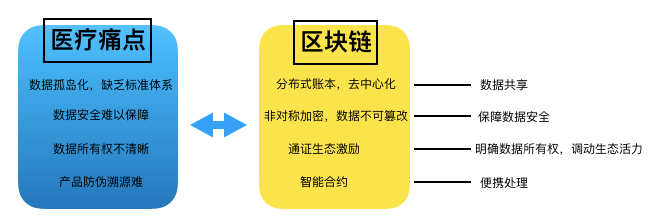
Pictures from OKEx Investment Research
Blockchain has natural advantages in data confidentiality, smart contracts, ecological incentives, etc., and has a high degree of agreement with the medical industry. It can provide multi-link security solutions for the medical industry, and can also promote the intelligent development of the medical industry. .
A BIS research report shows that by 2025, global healthcare market spending on blockchain is expected to reach $ 5.61 billion. By 2025, the adoption of blockchain technology can save the medical industry up to 100 billion to 150 billion US dollars in data leakage-related costs, IT costs, operating costs, support function costs and personnel costs, and reduce fraud and counterfeit products.
Blockchain + medical application scenarios
3.1 Medical Services: Medical Data Management
The use of blockchain technology in the healthcare industry is becoming a trend. It is mainly used to strengthen the supply chain management, security and information confidentiality, data authorization and process management of the pharmaceutical sector. In addition, blockchain technology helps patients record and manage patient health data, enabling patients to obtain personal financial benefits from the data.
3.1.1 Personal Electronic Medical Record
If you have a safe and complete personal health history that records every vital sign and can efficiently and accurately capture information related to the medications used, each doctor's diagnosis, patient disease and surgery, and other information, the quality and coordination of medical services is expected It will improve its performance, and the related costs and risks will be reduced accordingly.
The blockchain has data that cannot be tampered with, and any tampering will leave cryptographic evidence. As well as the ability to keep complex permissions of multiple private keys, access control of cases is achieved through smart contract technology. Solve the problems of data leakage, scalability, operability and data integration faced by electronic medical records.
Case: Health
Wizz announced the launch of a mobile platform that uses blockchain, mobile technology and data management technology to help patients organize their medical record data so that patients can securely access their databases anytime, anywhere. In addition, some specific organizations can use digital currencies to motivate patients to contribute their own health data to medical research. The Health Wizz mobile platform uses blockchain technology to provide consumers with the tools they need to enable stakeholders, including research institutions and pharmaceutical companies, to pool, manage, and share medical data together, while ensuring the integrity of the data and protecting the patient's Privacy has truly returned ownership of patient healthcare information to the patient himself.
3.1.2 Telemedicine
Telemedicine is an emerging discipline that continues to develop with the development of communication technology, computer networks, and multimedia technology, and its application to medicine. It uses multiple digital transmission methods to establish links between medical units in different regions, between physicians and patients, and complete tasks such as remote consultation, diagnosis and treatment, teaching, academic research, and information exchange. The application of this new model can help make the process of medical treatment from disorderly to orderly and time-saving, and can also solve the problem of imbalanced medical resources in developed and poor areas.
In the past, centralized telemedicine platforms may have exposed sensitive information related to patients and health due to internal errors or external attacks. Blockchain technology provides a feasible solution, which is a solution that can be completely transparent but respect the privacy of users.
Case: Medihealth is a decentralized telemedicine platform designed to integrate solutions serving the mobile health and telemedicine markets. By synchronizing electronic health records on the Medihealth platform, users can realize the secure storage of information and the secure access management of personal health information. In addition, users can check doctors' licenses and evaluate doctors through a database linked to licensed institutions. Medicohealth protects the privacy of patients and rewards doctors who provide online help while giving online medical help to improve the interaction efficiency between doctors and patients.
3.1.3 Smart Wearable Device Health Management
With the development of the Internet of Things and smart wearable devices, such personal continuous dynamic data can also be sent to the healthy blockchain. The data on the smart wearable device has the following advantages:
Data authenticity: upload data directly through smart wearable devices to ensure the validity and security of the data transmission process and prevent the existence of data fraud from the source.
Health management: use AI technology to analyze user physical data from wearable devices, provide personalized lifestyle interventions and preventive health management plans. Patients can also understand and manage their own health status.
Auxiliary treatment: With the help of blockchain autonomous cognitive identity consultant program management technology, hospitals can provide personalized medical care services based on personal health data over a period of time for wearable devices, improving the accuracy of treatment.
Case: Through its CafeWellHealth health optimization platform, Welltok uses AI technology to analyze user sign data from partners such as MapMyFitness and FitBit from wearable devices, and provides personalized lifestyle interventions and preventive health management plans.
3.1.4 Medical Big Data Analysis
Clinical diagnosis and treatment, medical research and development, and human genome research are all supported by huge personal basic health data. Without a large data set, it is difficult to establish the correlation between variants and traits, and it is difficult to study through machine learning to obtain truly meaningful results. However, such data is far from meeting the needs of scientific research institutions, mainly due to the fact that clinical diagnosis and treatment data and medication response data cannot be recorded and feedback in a timely manner, and the cost of personal genetic data testing is relatively high. The blockchain makes it possible to record and share this type of data.It can not only ensure the security and privacy of the data, but also provide the demand side with these data to obtain certain token rewards. It is bound to expand this type of data to a certain extent. Supply, and then promote the development of medical research through medical big data analysis.
Case: Technology startup Nebula
Genomics is using the blockchain to initiate DNA sequencing. After individuals pay the sequencing service provider, the sequencing data is owned by the individual. At the same time, the genetic sequencing data is also protected through the Nebula network, and access is controlled by everyone. To obtain genetic sequencing data, bio and pharmaceutical technology companies must buy from users, not from previous sequencing companies. This changes the ownership of genetic sequencing data.
3.1.5 Medical billing and insurance automation
In the medical field, patients, medical institutions, and insurance providers form an interactive relationship. Medical billing and insurance payments have low efficiency and complex services. Especially in terms of medical insurance, insurance institutions are responsible for fund collection, investment, and claim settlement. Often, management and operating costs are high. Claims payment and adjudication are to verify that all stakeholders meet and comply with agreed conditions in the contract, involving a large number of manual processes. Management fees. Medical institutions also spend a considerable amount of time each year in the process of insurance reimbursement, the compilation of medical records, insurance service providers and government audits.
Blockchain technology stores related data records on the blockchain in a distributed manner, realizing insurance data preservation, data cannot be tampered with, and contract disputes avoided. In addition, the processes that require professional doctors or notaries in medical billing and insurance can be automated and verified in a completely transparent and secure way through smart contracts. Smart contracts can automate most of the billing and payment procedures, thereby skipping middlemen, Reduce administrative costs and save time for both patients and medical institutions.
Case: LenderBot was launched in 2016 by blockchain companies Stratumn, Deloitte and payment service provider Lemonway. It allows people to register for customized micro-insurance products through the chat function of Facebook Messenger for high-value items exchanged between individuals. Insurance, and blockchain replaces the role of a third party in the loan contract.
3.2 Pharmaceutical Business: Traceability of Medical Equipment
3.2.1 Traceability of Drug Security
Data can be traced through "time stamp" technology and chain structure. Each event and transaction has a time stamp and becomes part of a long chain or permanent record. Through the consensus mechanism to jointly record and maintain data, prevent a participant from unilaterally modifying or deleting data, and ensure that drug information cannot be tampered with on the blockchain. Through blockchain technology, key details and related information of all links in the supply chain of medicines and drugs can be queried, including the date of production, price, efficacy, and circulation of the drug, and even traced back to the procurement stage of raw materials. If the drug transportation process is interrupted or the drug is missing, the data stored in the blockchain can provide a fast track channel for all parties and determine the last active location of the drug. In addition, once a drug with potential safety hazards is found on the blockchain network, the problem link is found through the drug circulation information recorded on the blockchain, which facilitates manufacturers and regulatory authorities to quickly intervene and recall the problematic drug as soon as possible.
Case: MIoT.AI is a Chinese company, established in May 2018. MloT. AI uses the Internet of Things technology to connect all aspects of the medical field through the MIoT.AI cloud medical chain, including medical devices (medical equipment, wearable devices), diagnostics (medical examination equipment, electronic medical records), drug distribution (pharmacy ERP), etc. The production, processing, storage, and sharing of data form an effective closed loop, which truly realizes the authenticity, immutability, confirmation, and accurate sharing of data. It can provide true and reliable data for precision medicine, health big data, and drug circulation. Data sources and security guarantees.
3.2.2 Medical Waste Tracking Solution
Similar to the anti-counterfeiting traceability of medicines, the medical waste tracking solution traces the origin, transportation and treatment of medical waste through the Internet of Things, sensors, smart trash bins and other equipment, and maintains incentives for participants.
Case: The Heian Chain medical waste tracking solution has been applied in Fujian Province. The National Health and Medical Commission started a blockchain pilot project in 2019, which will use the shared chain for a series of management measures including medical waste data collection, transfer records, monitoring of hospital circulation routes, and medical waste warehouse inventory monitoring. In this case, a series of nodes will be deployed, such as the collection, scanning, and sealing of medical waste by hospital care workers. The weighing, transportation, transfer, and final destruction of medical waste during transportation will all store data through APP. Come down to ensure the entire process of medical waste supervision from source to end.
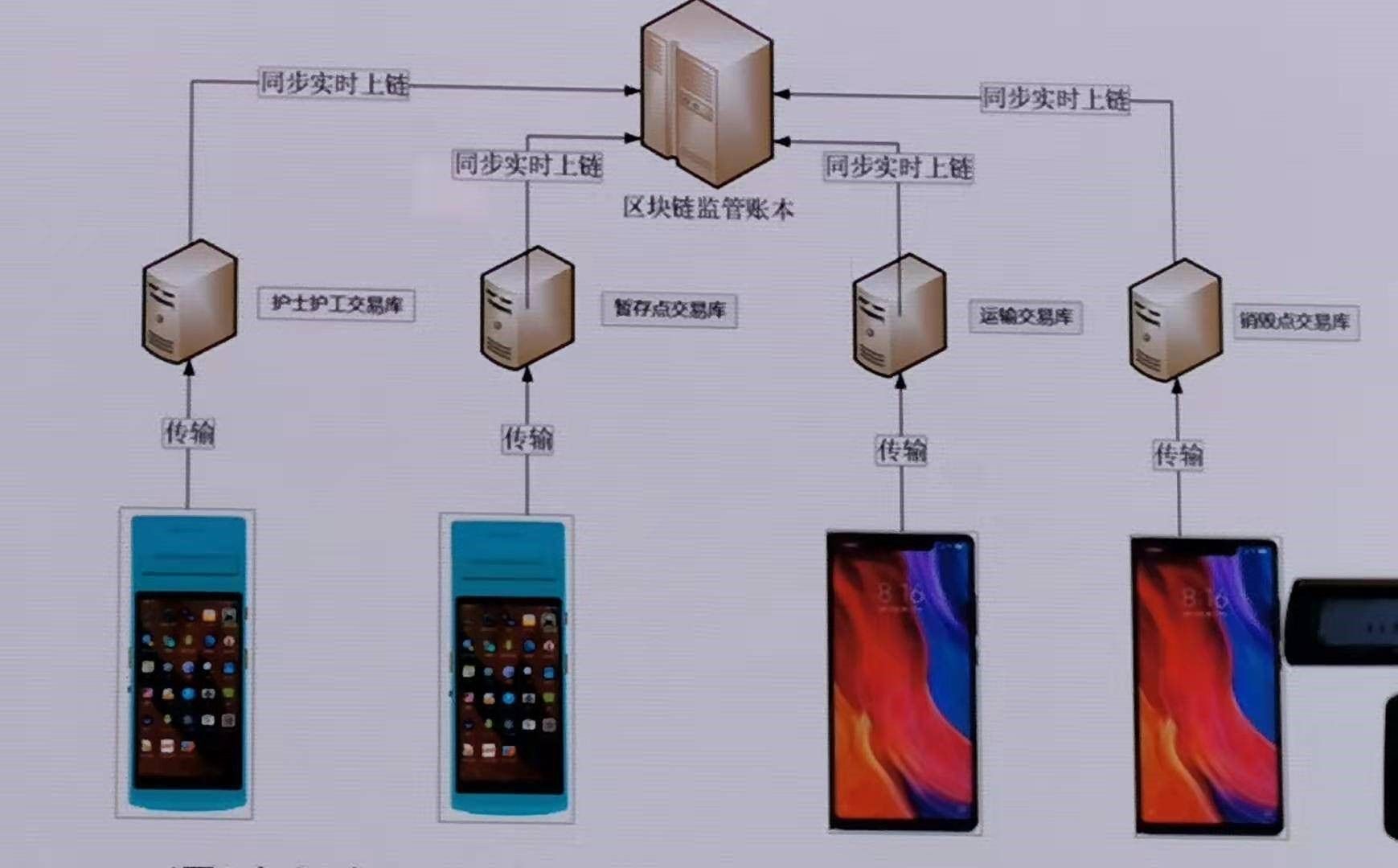
Opportunities and challenges of blockchain + medical
4.1 Opportunities
4.1.1 Solve the existing pain points of the medical industry
The application prospects of blockchain technology in the medical and health field are widely optimistic, and it is expected to play an active role in medical data sharing, medical insurance, drug traceability, and wearable devices.
The combination of medical information and big data is an inevitable direction for the development of the medical industry. The use and sharing of medical data based on cloud storage and cloud computing has an inestimable role in promoting the advancement of the medical industry and improving the level of public health. , High management costs, lengthy patient reimbursement process, medical records are difficult to organize. Smart contracts and process automation using blockchain technology are conducive to reducing management costs, improving efficiency, and achieving credible, monitorable, and traceable information; drug supervision is difficult and costly, and the use of blockchain traceability and timeliness Sharing, extensive updates, and credible data can improve supply chain management; in the future, wearable devices are expected to be integrated into the medical IT ecosystem through blockchain technology. With the help of blockchain technology, smart ecological devices can be completely independent of the constraints of mobile phones and other devices.
4.1.2 Promote the development of AI in the medical field
The core of AI + medical development lies in "algorithms + effective data". The computing power at the base layer is the basis for building the ecology. The algorithms, frameworks, and general technologies at the technical layer are the basis for building the technology moat. They all belong to the large ecological infrastructure of the artificial intelligence industry. Make an investment. With the improvement of blockchain medical data interconnection and the establishment of sharing mechanisms, the development of the AI + medical industry will accelerate. In the future, it can be applied to the diagnosis of diseases and based on data collection and analysis in various medical fields such as sleep monitoring, clinical nursing, and chronic disease monitoring.
4.1.3 Promote the development of genomic engineering
Blockchain can achieve secure storage and incentive sharing of genomic databases. On the basis of genomic big data, deciphering the genetic code promotes the development of a large number of new technologies such as DNA sequencing technology, gene mutation technology and gene amplification technology. On this basis, it will also drive the research and development of artificial hormones, biomedicine, and artificial organs.
4.2 Challenges
4.2.1 Medical institutions have varying degrees of informatization coverage
The main source of medical big data is hospitals, and the collection of hospital medical big data mainly depends on the degree of informatization in the hospital. Due to the relatively short development time of informatization in medical institutions, the overall coverage of informatization is insufficient. Taking China as an example, there are some differences between tertiary hospitals and sub-tertiary hospitals, economically developed areas, and economically underdeveloped areas. In particular, the coverage of medical informationization solutions with high concentration and sharing is not enough. The 2015-2016 China Hospital Informatization Survey Report released by the Chinese Hospital Association Information Management Professional Committee (CHIMA) statistics report shows that among the 342 third-level hospitals and 194 third-level hospital sample hospitals, the electronic medical record system (EMR) The implementation ratio is 71.05%, while the regional health information system implementation ratio is only 8.77%. From a national perspective, the medical software informatization market is far from saturated.
4.2.2 Reliability of Medical Data Sources
The traceability of the blockchain drug during its incubation period also needs to overcome three major obstacles: the problem of counterfeiting and packet loss at the source of production, that is, the blockchain can only provide information technology and cannot solve the problem of counterfeiting and packet loss; the reliability of data sources, That is, it can ensure that the uploaded data is not tampered, but it cannot guarantee that the data itself is not artificial due to human factors; the issue of stakeholder participation, that is, the premise of blockchain application is the willingness of all stakeholders to share and guide the company The chain also needs some education.
4.2.3 Bottleneck of Blockchain Technology Development
The tps of the blockchain and the security of smart contracts still have a lot of bottlenecks, which depend on the emergence of high-performance public chains. The main disadvantages of the current blockchain are high latency and slow transaction rates. At present, blockchain applications are still in the initial development stage. Compared with Internet technology, people can use browsers, APPs and other specific applications to realize the browsing, transmission, exchange and application of information. However, the blockchain obviously lacks such efficient applications and requires breakthrough progress at the technical level. .
4.2.4 Legal risks of tokens
Due to the differences in culture, cognition, and economy among countries, it is bound to create differences in attitudes and policies on emerging technologies. In view of the unknown risks to the emerging technology, countries around the world currently do not have relatively unified market management principles and legal regulatory environments for the development of blockchain projects. Among them, the performance of blockchain project tokens is the most prominent, such as compliance in some regions and prohibition in some regions. The chaotic global policy environment is also one of the important constraints for integration and expansion.
References:
IBM Institute for Business Value: Healthcare industry gathers on blockchain
https://www.useit.com.cn/thread-14513-1-1.html
Blockchain Industry Research Series: Medical Data and Blockchain Analysis Report | Chain Catcher
https://mp.weixin.qq.com/s/Y3oxCwFvyDygWRDAk-zjSA
Blockchain + Precision Medicine: Application and Case Analysis of Blockchain in the Medical Industry
https://wenku.baidu.com/view/15e0409748649b6648d7c1c708a1284ac85005fc.html
Blockchain + Medical Industry Research Report
https://www.jianshu.com/p/b5b9aca0e36e
Whale Associate Research Institute: 2018 Blockchain Vertical Industry Report (traceable)
https://www.useit.com.cn/thread-19176-1-1.html
China AI Medical Industry Report
https://www.cn-healthcare.com/article/20190920/content-523859.html
Risk reminder: All articles of OKEx investment research do not constitute investment recommendations. Investment is risky. Investment should consider personal risk tolerance. It is recommended to conduct in-depth inspection of the project and make good investment decisions.
Welcome to reprint, please indicate the article from
OKEx ( www.okex.com )
We will continue to update Blocking; if you have any questions or suggestions, please contact us!
Was this article helpful?
93 out of 132 found this helpful
Related articles
- Babbitt weekly election 丨 Do you panic when 2020 starts like this?
- Decentralization cannot be done in one step, A16z talks about three factors for the success of cryptocurrency projects
- Viewpoint | Talking about Bitcoin from the Theory of Monetary Information: Bitcoin is the ultimate safe-haven asset
- Weekly data report on the BTC chain: The data on the chain rebounded quickly after the rebound, and the sluggish situation is still difficult to get out of
- ChainLink, the oracle connecting the two worlds
- Beijing will promote blockchain technology applications in more than 20 areas including real estate transactions
- Featured | Top 10 content producers in the currency of Twitter; Is Bitcoin 2020 really like the early Internet?






